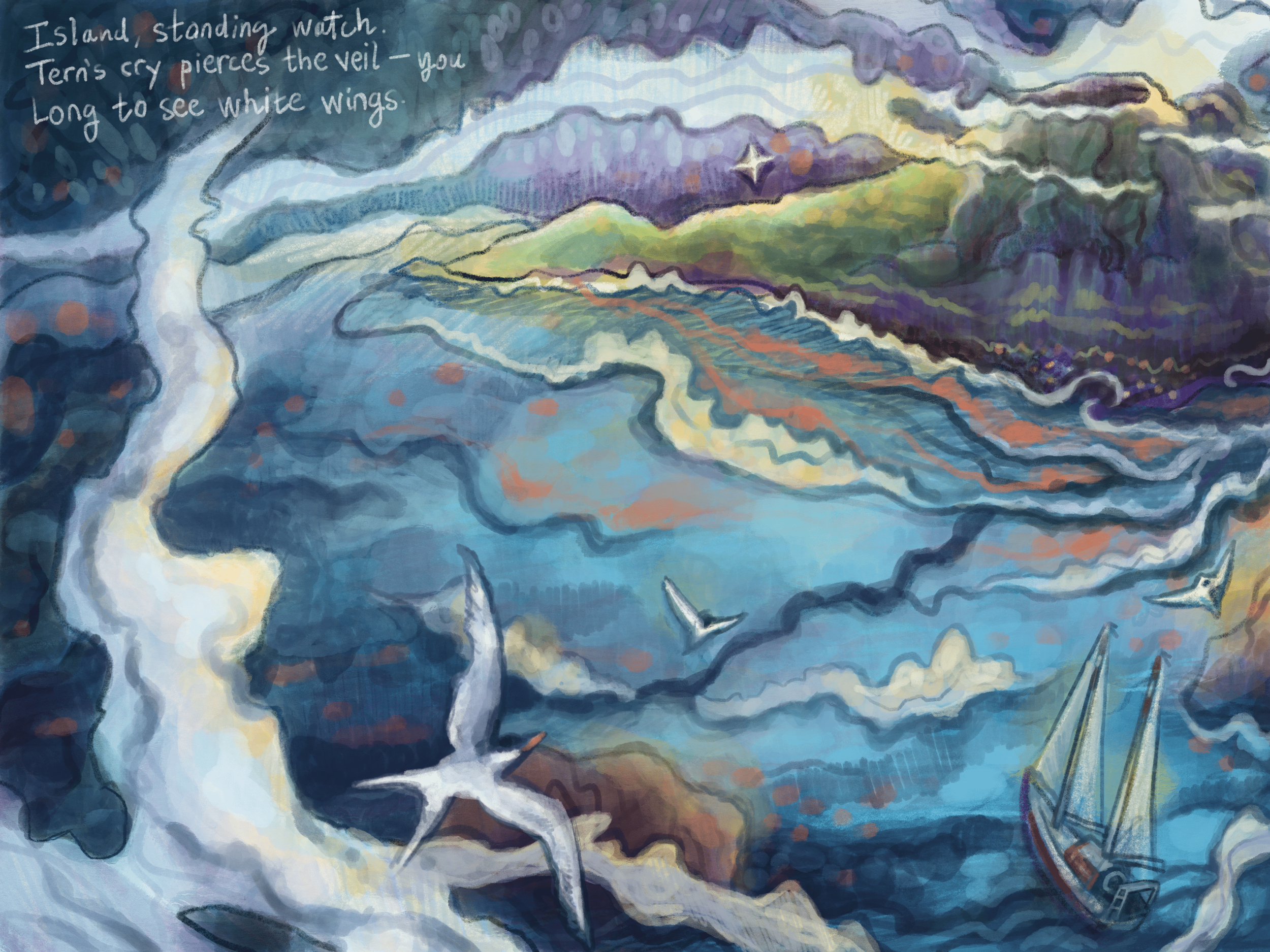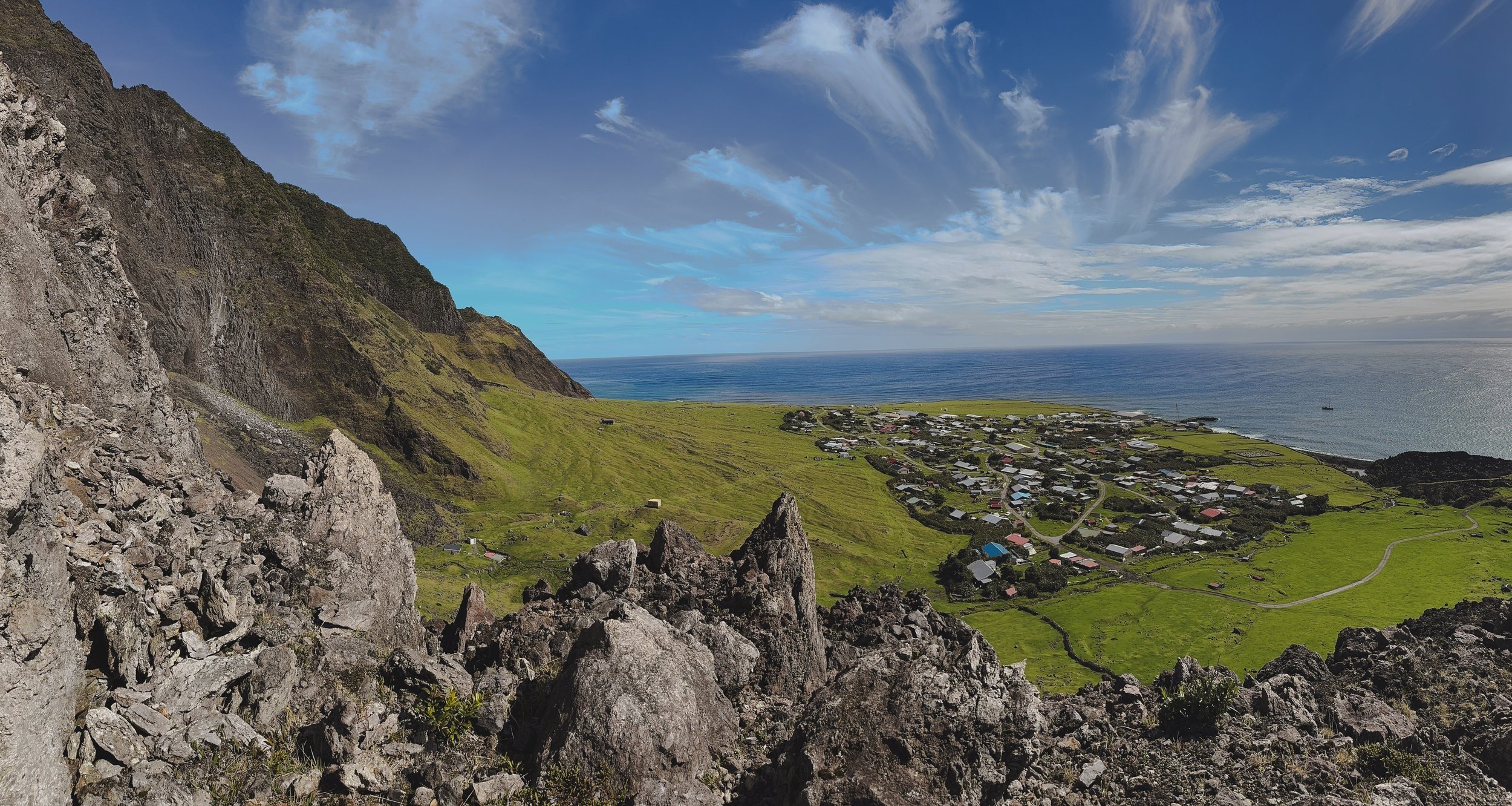Imaginary Island
Magma stirs with ash. Seawater pressure cooker, 200 atmospheres pressing down like a hot iron. Boiling, steaming, whistle shrieking. One Pleistocene morning, a raw new rock rises up from soupy slumber.
The Ice Age recedes. Early humans begin to stride the earth, then spin into seafaring civilisations. For eras, the island that would become known as Tristan da Cunha stands in waiting, quietly influencing ocean currents, the global water cycle, and enticing pelagic seabirds home. Yet, the subtle presence of the 98km2 uninhabited landmass must have affected all that unfolded in the story of humanity. Casting eddies as dice across the vast Atlantic, remaking each wave that lapped the shores of Africa, Europe, and the Americas. Perhaps a skilled early navigator suspected the archipelago from a long way off, before Admiral da Cunha first sighted the island of his namesake in the 1500s.
Spectacled petrel, endemic to the high plateaus of Inaccessible Island
A trio of Great Shearwaters, who migrate as far as Greenland and always return home to the Tristan Archipelago
The Butterfly Effect only grew. Tristan da Cunha was first of interest to the British in a chess move to prevent Napoleon escaping Saint Helena. It became a strategic naval outpost for the Empire, and a critical weather station during WWII. A pivot point, turning the tides of history.
When I was ten, we had a school assignment to imagine an island — the geology, ecology, folklore, language — suited to a chosen latitude and longitude. I can’t remember much about the Imaginary Island I created at 0°N, 0°E (the crossroads of the Prime Meridian and the Equator, now considered the location of the conceptual ‘Null Island’) but perhaps it’s why islands constantly pull at my curiosity. Evolutionary experiments where anything seems possible, constrained by a relatable scale. Darwin’s finches, sooty albatrosses, giant tortoises, flightless parrots, tropical penguins, flying foxes.
As if a dream
I spent three years imagining Tristan da Cunha, since I sailed with VINSON as a celestial navigation student in 2022. That year, raging headwinds formed an impassable wall, and we had to divert to Gough Island. I was heartbroken (soon, completely enraptured by Gough Island), and never would have guessed I’d be back so soon as a crew member on twin sister ship AMUNDSEN.
ISLAND, STANDING WATCH / TERN’S CRY PIERCES THE VEIL — YOU / LONG TO SEE WHITE WINGS
I wondered, has Tristan da Cunha long been imagining VINSON OF ANTARCTICA and AMUNDSEN? Every moment of every day, keeping watch, with thousands of miles of water and clouds running every direction. The tireless and vigilant watchkeeper might spot a sailing rig at most five times a year.
Ian and Kate taking star and planet sights at twilight
By the mysterious workings of the universe’s chain reactions — long ago tipped by the formation of Tristan da Cunha itself — the variables of weather, wind, sea state, timelines, and accurate dead reckoning all came together for us this year. After two weeks of drawing tiny lines and measuring the angle of the sun off the horizon, our apprentice celestial navigators located Inaccessible and Nightingale Islands by bouncing radio waves off them (RADAR), and charted a course between.
In the earliest hours of the morning, we watched Venus, Saturn and Mercury crest above the silhouette of Queen Mary’s Peak, the lights of Edinburgh of the Seven Seas twinkling. Terns flew near to inspect us. Kelp latched hold of our rudder and clung. I was overwhelmed with the smell of plants and earth, sweet notes over the salt spray.
First light arriving to Tristan da Cunha
Dropping the sails to anchor
At anchor under the sheer cliffs
As we dropped anchor in the swaying swell, a large group of Tristanians assembled at the edge of the harbour taking photos of us, waving. Paul, Claire, Chris, Miquel and Ian dinghied ashore to greet them. Yannick serenaded Catalan guitar to the galley-ware percussion, sliding port, starboard, port.
Paul and Ian inflating the dinghy
Yannick playing guitar
I scrambled off-trail up a basalt hill. Sweaty from the demands of wobbly legs, I paused and ate an egg sandwich. I breathed in this scene that was no longer a dream, but just as precious and precarious. Careening cliffs. Cumulus clouds for a cap. Surf battering beach. Lawn chairs posing with lava rocks. Multi-coloured rooftops reverberating with church bells, barking dogs and motorcycles.
Views from the hill overlooking Edinburgh of the Seven Seas and AMUNDSEN at anchor
Scenes from Edinburgh of the Seven Seas
Claire pouring champagne for Miquel and Chris
Onward, we sailed into the night, with traces of our footfalls and AMUNDSEN’s wake to be digested in the molten chambers below the seabed, frothing with yet unimagined improbabilities. Just one, could turn the forces of the world.
Photos by Chris Streiff and Kate Schnippering
Kate Schnippering
Amundsen Crew















